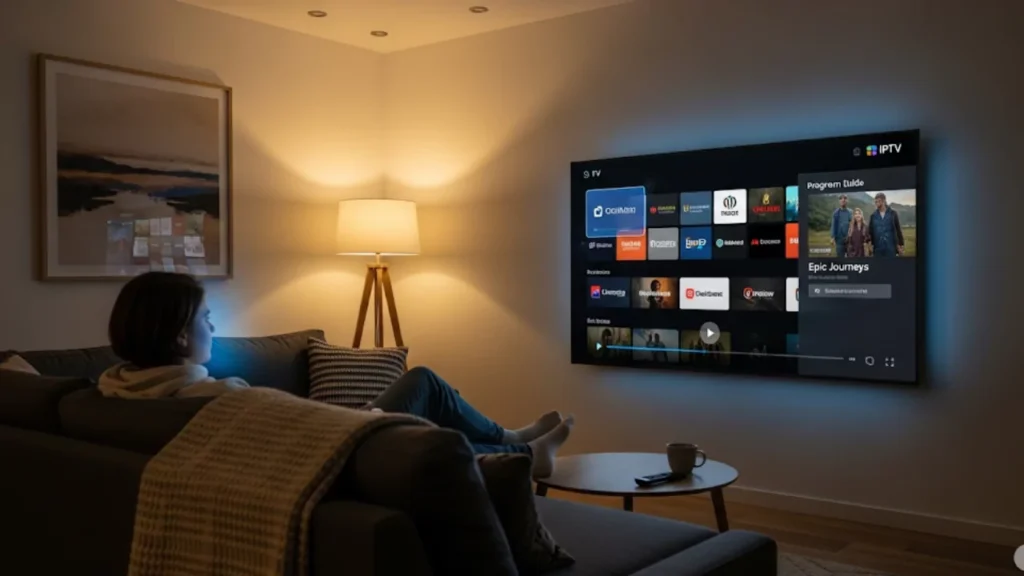what is the difference between ott and iptv ? Streaming has changed how we enjoy entertainment. However, the tech behind your favorite shows can be confusing. How you watch, using a set-top box or streaming apps on your smart TV, can really change your experience and costs.
IPTV (Internet Protocol Television) streams live channels and on-demand content via dedicated provider-managed networks, offering reliable quality, DVR features, and traditional channel guides. OTT services like Netflix and Prime Video deliver content over the public internet, offering greater device flexibility and personalized recommendations. Choose IPTV for a stable, cable‑like experience; OTT if you need portability and multi-device access. Necessary setup: high-speed internet, compatible devices, and legal service provider.
What Makes IPTV Different From OTT?
Understanding IPTV
Internet Protocol is used by Internet Protocol Television (IPTV) to transmit video content. It works through a private, controlled network. IPTV is not like traditional cable TV. It sends digital signals straight from your service provider.It makes use of a broadband connection or fiber optics. This network type ensures consistent content quality and reliability.
The technology uses a multicast method to transmit content. This enables the provider to make effective use of bandwidth throughout their network.
Understanding OTT
OTT streaming provides video content directly to users via the public internet. It avoids the usual distribution channels. Examples of popular streaming platforms are Netflix, Hulu, and Apple TV. They work on their own, separate from cable and satellite TV providers. These streaming services use content delivery networks to reach audiences worldwide.
OTT video platforms use AI to give you personalized recommendations. They also use adaptive bitrate streaming. This helps ensure the best content quality based on your internet speed. This approach helps content creators and media companies take charge of their video distribution.
How Do These Technologies Work?
How IPTV Works
IPTV operates through dedicated network infrastructure provided by your Internet Service Provider. The system uses IP protocols to stream video content over managed networks. This ensures a smooth experience for users. Content travels through fiber internet or high-speed broadband connections directly to your home.
- The service requires specific streaming devices or set-top boxes configured by your provider
- Content delivery occurs through controlled bandwidth allocation
- Quality remains stable regardless of peak usage times at your local service area
- Digital Rights Management protects content throughout the transmission process
How OTT Delivers Content
OTT streaming uses your internet connection to send video content via apps or websites. These streaming services use adaptive HTML5 players. They also rely on content delivery networks. This helps optimize video traffic for your device and connection speed.
- Content flows from cloud-based servers through public internet infrastructure
- Adaptive bitrate streaming adjusts quality automatically based on network conditions
With multidevice streaming, you can enjoy content on your smartphone, tablet, smart TV, or media player, such as the Amazon Fire Stick. This gives you more flexibility than traditional video methods.
What’s the User Experience Like?
IPTV’s Channel-Based Structure
IPTV maintains the familiar cable TV experience with channel guides and scheduled programming. The Electronic Program Guide makes it easy to find content. Features like Time-Shifted TV and cloud DVR improve how you watch. Customer service typically comes directly from your Internet Service Provider.
OTT Platform Flexibility
Unprecedented flexibility in content consumption and device accessibility is provided by OTT streaming. Users can pause shows on one device. Then, they can resume on another. Also, personalized recommendations make it easier to find new content. Streaming apps increase engagement by offering interactive viewing features and user interaction capabilities.
Content Selection and Availability
Content availability varies significantly between these delivery methods. IPTV usually comes with local channels, live sports, and regional shows. It’s often part of internet service packages. OTT platforms target a worldwide audience. They provide original shows and on-demand content. Still, some content may have geographical restrictions due to regulations.
Why Choose IPTV Over OTT?
High-Quality Streaming Stability
IPTV delivers consistent content quality through dedicated network infrastructure and controlled bandwidth allocation. The private network approach removes typical internet congestion problems. This means public streaming services can perform reliably, even when usage is high.
Traditional TV Experience
Many viewers prefer IPTV’s familiar channel-based interface with Electronic Program Guide navigation. Features like scheduled shows, live sports, and local channels offer the classic TV experience that many families love.
Integrated Service Bundles
Internet Service Provider packages often bundle IPTV with internet and phone services. This can lower your total subscription costs. This bundled approach provides better value and simpler customer service with one provider.
What Are OTT’s Key Advantages?
Accessibility on Multiple Devices
OTT streaming is great for device accessibility. It works on smart TVs, mobile devices, and more. Cloud technology makes it easy to sync content across different platforms. Also, HTML5 player support lets it work on different devices without extra hardware.
- Access content anywhere with internet connectivity
- No geographic limitations for most streaming services
- Supports various streaming devices and media players
- Enables global reach for content creators and viewers
Personalized Content Delivery
OTT platforms use Artificial Intelligence to suggest shows and movies just for you. They look at what you watch and what you like. This data-driven approach improves how users find content and engage with it. It’s more effective than old linear programming schedules.
No Geographical Restrictions
OTT streaming is available anywhere in the world. This is different from IPTV services. IPTV depends on certain coverage areas from Internet Service Providers. Content creators can connect with global audiences. Viewers can enjoy a variety of shows from different regions and cultures.
Are There IPTV Limitations to Consider?
Limited by Geographical and Network Constraints
IPTV depends on your Internet Service Provider’s network and coverage area. Service quality directly correlates with your provider’s network investment and maintenance.
Higher Set-up Costs
Setting up IPTV usually needs special equipment and professional help. It may also cost more in subscription fees than OTT options. The set-top box, streaming devices, and service activation can be tough for consumers on a budget.
What About OTT’s Drawbacks?
Internet Speed Dependency
- OTT streaming quality relies on your internet connection speed and stability.
- Consistent bandwidth is essential for smooth video streaming.
- Network congestion can greatly affect content quality.
- Adaptive bitrate streaming offers some improvement, but connectivity issues can still pose challenges.
Variable Streaming Quality
- OTT services operate on open internet networks, unlike IPTV’s controlled environment.
- They compete with other internet traffic for bandwidth.
- This may result in buffering, lower quality, or interruptions when usage is high in your area.
How Do Monetization Models Differ?
Subscription-Based IPTV Services
IPTV usually runs on monthly subscription fees. These fees often come with internet services from your Internet Service Provider. This model gives providers steady revenue. It also offers subscribers complete channel packages and premium features.
Monetization models usually feature:
- Tiered service levels
- Premium channel add-ons
- Pay-per-view content
Customer loyalty programs and long-term contracts help providers keep steady revenue. This allows them to invest in improving network infrastructure.
Pro Tips for Choosing Your Streaming Solution
Think about how you watch, the quality of your internet, and what devices you like. These factors help you decide between IPTV and OTT streaming services. Evaluate content availability, pricing structures, and technical requirements for your specific situation.
- Test your internet speed during peak hours before committing to OTT services
- Compare bundled IPTV packages with standalone streaming service costs
- Consider device compatibility and streaming apps availability
- Research customer service quality and technical support options
Final Thoughts: Which Streaming Approach Works Best?
IPTV and OTT streaming each have unique benefits based on your needs. IPTV gives you stable services and classic TV features through special networks. OTT offers flexibility and lets you access global content through your internet.
The video streaming industry is changing fast. 5G technology, edge computing, and Cloud TV innovations are making delivery better. Choose based on your viewing habits, tech needs, and budget for lasting satisfaction.
Frequently Asked Questions
1. What does OTT mean on my TV?
OTT (Over-The-Top) means streaming services that send content straight through the internet. They skip traditional cable and satellite providers.
2. How is OTT different from IPTV?
OTT sends content over the open internet without control from operators. IPTV, on the other hand, uses a dedicated network to provide TV services.
3. Is OTT better than cable?
OTT services usually cost less and provide on-demand content. But, they may not have live local channels. Also, internet quality can affect them.
4. What is IPTV and how does it work?
IPTV delivers TV content via IP networks. It lets you watch live TV and on-demand videos. You can access it through apps, smart TVs, or streaming devices.
5. Is IPTV legal in the USA?
IPTV is legal if offered by licensed providers. Illegal IPTV streams that don’t have broadcasting rights are against the law.


